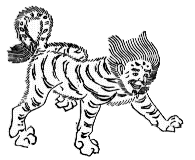[ . BACK to DARUMA MUSEUM TOP . ]
. Onipedia - 鬼ペディア - Oni Demons - ABC-List - .
::::::::::::::::::::::::::::::
kishin, kijin, onigami 鬼神の伝説 Oni Deity Demon Legends
. Shinto shrine names including 鬼 ONI .
Kishin Jinja 鬼神神社 - Kijinja, Ki Jinja 鬼神社 "Demon Shrine" , Oni Shrine .

鬼神 - Oni- Gami
矢野隆 Yano Takashi
This wild and fearful deity can not be seen or heard by humans.
onigami オニガミ wild, fearful deity
Often the reikon 霊魂 soul of a human being can turn to a
yuuki 幽鬼 Yuki - revengeful demon or monster spirit
. goryoo 御霊 Goryo- vengeful spirits .
To appease their kijin きじん souls, shrines were erected for them.
The most important are
Sudo, Sudoo Tenno 崇道天皇 (? - 785) and his son,
Iyo Shinno 伊予親王.
his mother, Fujiwara Fujin, 藤原婦人
Fujiwara Hirotsugu, 藤原広嗣
Tachibana Hayanari, 橘逸勢
Bunya no Miyata Maro 文室宮田麻呂
Kibi no Makibi 吉備真備
Sugawara Michizane 菅原道真
kijin, when referring to a living human demon, can be written with the Chinese characters: 鬼人
The Buddhist sutra 仁王経 Ninno-Kyo states
『国土乱れん時はまず鬼神乱る。鬼神乱るるがゆえに万民乱る』
- - - - - Proverbs - - - - -
kiseki ni iru 鬼籍に入る to die
(and be registered in the Demon family register for the dead)
. oni no nyooboo ni onigami (kijin) 鬼の女房に鬼神 .
::::::::::::::::::::::::::::::
Dokurojō 髑髏杖 Staff with Human Skull in the hands of Kannon Bosatsu
鬼神を降伏する. Conquers demons and demonic influences.

Symbolizes the impermanence of life.
A simile for people who are free from discriminating thoughts. Ikkyuu Soujun 一休宗純 (1394-1481), the renowned Zen monk (and poet) of Daitokuji Temple 大徳寺 in Kyoto, reportedly wandered about during new year celebrations brandishing a staff surmounted by a human skull in his effort to remind people of their thin grasp on life.
- reference : Mark Schumacher -
..............................
kioo 鬼王 Kio, Ki-O, the Demon King
「福は内、鬼は内」- Fuku wa Uchi, Oni wa Uchi!
- 稲荷鬼王神社 Inari Kio Jinja (新宿区歌舞伎町)Shinjuku, Tokyo
. oni wa uchi 鬼は内 Demons come in! .
..............................
群馬県 Gunma 藤岡市 Fujioka
At the riverpool あいのかま Ainokama in the gorge 鮎川の蛇喰 Jabami valley of the river Ayugawa there lived a wicked 悪鬼王 Demon King, who took human lives for his offerings.
The hero Yamato Takeru came to punish him.

. Yamatotakeru 日本武尊 Prince Yamato Takeru .
legendary prince of the Yamato dynasty
::::::::::::::::::::::::::::::
青森県 Aomori
Mount Iwakisan and the Onigami
鬼神社(きじんじゃ)Ki Jinja, Kijin-Ja at 弘前市鬼沢菖蒲沢地区 Hirosaki-shi, Onizawa
鬼神伝説 - The Kishin legend of Onizawa
There is a legend in Onizawa describing a benevolent Oni, more of a mountain-man than a demon.
As the story goes, the Oni was a friend of a villager 弥十郎 Yajuro, and offered to assist in the construction of a dam to collect water for his rice paddies. He did so under the condition that no-one watched him as he worked. Naturally, the villager's wife breaks the rule by sneaking over to spy on the Oni. The Oni runs away, never to appear again; however, he leaves in such a hurry that he forgets all of his tools. The metal remains of these massive ogre-sized tools — a saw, an ax, a hoe, etc — are now collected and displayed at the Oni shrine in Onizawa.
(Told by Joshua Solomon)
. oniko, oni-ko 津軽の鬼子伝説 Tsugaru Oniko Legends .
Other places related to the Oni in Onizawa
鬼の腰掛け柏
鬼の土俵
The villagers in Onizawa have a fond relationship with this Oni Deity - 鬼が神様なのである.
At Setsubun, they do not throw beans to drive the Oni away.
At the Boy's festival they do not thatch the roof with mugwort and iris to drive the Oni away.
The Oni here might have been some outlaws in hiding or even Koreans in hiding, which Tamuramaro expelled.
. Sakanoue no Tamuramaro 坂上田村麻呂 . - (758 - 811)
::::::::::::::::::::::::::::::
. Shiga 滋賀県の鬼伝説 Oni Demon Legends .
鬼は宝として隠れ蓑、隠れ笠、浮き靴、剣などを有する。
.
Shuten Doji 酒呑童子 サケノミワラシ
摂津守頼光朝臣が勅を受けて酒呑童子を退治した。
..............................
京都府 Kyoto
. Kijin : Kurama no oni taiji 鞍馬の鬼退治 .
..............................
岡山県 Okayama
Ura 温羅
垂仁天皇の時代、吉備国で略奪を繰り返す百済の鬼神、
..............................
山口県 Yamaguchi 豊浦郡 豊浦町
ushonigami 牛鬼神
夫がいない間、妻のもとに18・9の若者が毎夜通ってきた。
::::::::::::::::::::::::::::::
- reference : nichibun yokai database 妖怪データベース -
- reference - 日本語 鬼 -
55 to explore (04)
::::::::::::::::::::::::::::::
. Kijin no O-Matsu 鬼神のお松 The female bandit O-Matsu .
"The Evil Omatsu"
::::::::::::::::::::::::::::::

. - - - Join the Onipedia friends on facebook ! - - - .
::::::::::::::::::::::::::::::
. Onipedia - 鬼ペディア - Oni Demons - ABC-List - .
. Tengu 天狗と伝説 Tengu legends "Long-nosed Goblin" .
. - yookai, yōkai 妖怪 Yokai monsters - .
. Legends and Tales from Japan 伝説 - Introduction .
. Mingei 民芸 Regional Folk Art from Japan .
::::::::::::::::::::::::::::::
[ . BACK to DARUMA MUSEUM TOP . ]
[ . BACK to WORLDKIGO . TOP . ]
- #kishin #demongod -
::::::::::::::::::::::::::::::
--
Posted By Gabi Greve to Kappa - The Kappapedia on 3/26/2017 01:12:00 pm











































